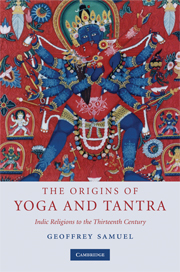Book contents
- Frontmatter
- Contents
- List of figures
- Preface
- 1 Introduction
- 2 Stories and sources
- PART ONE MEDITATION AND YOGA
- PART TWO TANTRA
- 9 The classical synthesis
- 10 Tantra and the wild goddesses
- 11 Subtle bodies, longevity and internal alchemy
- 12 Tantra and the state
- 13 The later history of yoga and Tantra
- 14 Postlude
- References
- Index
10 - Tantra and the wild goddesses
Published online by Cambridge University Press: 05 June 2012
- Frontmatter
- Contents
- List of figures
- Preface
- 1 Introduction
- 2 Stories and sources
- PART ONE MEDITATION AND YOGA
- PART TWO TANTRA
- 9 The classical synthesis
- 10 Tantra and the wild goddesses
- 11 Subtle bodies, longevity and internal alchemy
- 12 Tantra and the state
- 13 The later history of yoga and Tantra
- 14 Postlude
- References
- Index
Summary
If much of Chapter 9 dealt with the cult of respectable, high-status deities, linked with the new image of kingship in the new Brahmanical and Buddhist states of the post-Mauryan and the Gupta periods, on both śramaṇa (Buddhist) and Brahmanical sides, Chapter 10 introduces religious forms of a less respectable and more ambiguous kind. The practice of these forms of religion was for the most part, initially at least, the preserve of more marginal groups. It will become evident, however, that they were not unimportant for all that, and they were to become more important over the following centuries.
Tantric studies, and especially Tantric historiography, as Urban (1999), Wedemeyer (2001) and others have noted, has, like other fields of study, been historically dominated in various ways by Western fantasy (partly shared by Indian scholars under Western influence). The term itself is problematic, particularly in the Śaiva, Vaiṣṇava and Jaina contexts, though less so for the Buddhists where the Tibetans had an explicit category of works in the canon labelled ‘Tantra’ (rgyud). Many of the Śaiva works that are now customarily labelled ‘Tantric’ might have been called kaula or by other labels, particularly before the tenth and eleventh centuries; Tantra as a standard category of Śaiva texts emerged only at a fairly late period.
Defining Tantra remains a problematic business; the articles in Katherine Harper and Robert Brown's collection The Roots of Tantra (2002) spend quite a few pages on this topic without providing much enlightenment.
- Type
- Chapter
- Information
- The Origins of Yoga and TantraIndic Religions to the Thirteenth Century, pp. 229 - 270Publisher: Cambridge University PressPrint publication year: 2008



